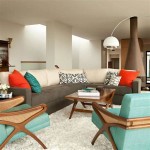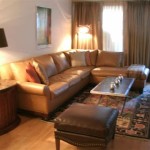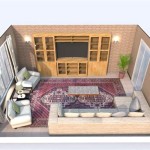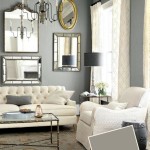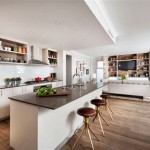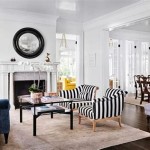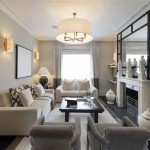```html
Room Design Ideas for Living Rooms: Creating Functional and Stylish Spaces
The living room often serves as the central hub of a home, acting as a space for relaxation, entertainment, and social interaction. Consequently, careful consideration of its design is essential for creating a functional and aesthetically pleasing environment. Effective living room design requires a balanced approach, integrating elements of comfort, style, and practicality to cater to the specific needs and preferences of its occupants.
This article will explore various room design ideas for living rooms, focusing on key aspects such as space planning, color palettes, furniture selection, lighting, and decor. By thoughtfully addressing these elements, individuals can transform their living rooms into inviting and versatile areas that reflect their personal style and enhance their overall living experience.
Optimizing Space Planning and Layout
Space planning forms the foundation of any successful living room design. Before selecting furniture or decor, it is crucial to analyze the dimensions of the room and consider its intended function. A well-planned layout will maximize available space, facilitate smooth traffic flow, and create a sense of visual harmony.
One common approach is to identify a focal point within the room. This could be a fireplace, a large window with a scenic view, or a statement piece of artwork. Arranging furniture around the focal point creates a sense of order and draws the eye into the space. For example, in a living room with a fireplace, a sofa and armchairs can be positioned facing the fireplace, fostering a cozy and inviting atmosphere. In contrast, if the room boasts a panoramic view, furniture can be arranged to take advantage of the natural light and scenery.
Consider the different zones within the living room. A reading nook with a comfortable armchair and a floor lamp can be created in a quiet corner. Alternatively, a home entertainment zone with a television and comfortable seating can be established for movie nights or gaming sessions. Defining these zones helps to delineate the space and ensures that each area serves a specific purpose.
Traffic flow is another important aspect of space planning. Ensure that there is ample space for people to move freely around the room without obstruction. Avoid placing furniture in pathways or creating bottlenecks that can impede movement. Consider the placement of doorways and windows when arranging furniture to maximize natural light and ventilation.
The size and shape of the room will influence the optimal layout. In smaller living rooms, it is essential to maximize space by using multi-functional furniture, such as a sofa bed or a coffee table with storage. Vertical space can also be utilized by incorporating shelving units or wall-mounted storage solutions. In larger living rooms, it is possible to create more distinct zones and experiment with different furniture arrangements.
Selecting Color Palettes and Materials
Color plays a significant role in shaping the ambiance and mood of a living room. The choice of colors can influence the perception of space, evoke emotions, and create a sense of visual interest. When selecting a color palette, consider the size of the room, the amount of natural light, and the desired atmosphere.
Lighter colors, such as white, beige, and pastel shades, can make a room appear larger and brighter. These colors reflect light and create a sense of airiness. They are particularly suitable for smaller living rooms or rooms with limited natural light. Darker colors, such as navy blue, forest green, and charcoal gray, can create a sense of intimacy and sophistication. These colors are best used in larger living rooms or as accent colors to add depth and drama.
The use of color theory can further enhance the design of the living room. Complementary colors, such as blue and orange or yellow and purple, can create a vibrant and dynamic contrast. Analogous colors, such as blue and green or red and orange, can create a harmonious and soothing effect. Monochromatic color schemes, which use different shades and tints of a single color, can create a sense of elegance and sophistication.
Consider the materials used in the living room. Natural materials, such as wood, stone, and leather, can add warmth and texture to the space. These materials can be incorporated through furniture, flooring, and wall coverings. Textiles, such as wool, cotton, and linen, can add softness and comfort to the room. These materials can be used for upholstery, curtains, and rugs.
The interplay of textures can also contribute to the overall visual appeal of the living room. Combine smooth surfaces, such as glass and metal, with rougher textures, such as textured fabrics and exposed brick, to create a sense of depth and interest. The use of different textures can also help to define different zones within the living room.
Integrating Lighting and Decor Elements
Lighting is a crucial element of living room design, influencing the ambiance, functionality, and visual appeal of the space. The use of layered lighting, combining ambient, task, and accent lighting, can create a versatile and well-lit environment. Ambient lighting provides overall illumination, task lighting serves a specific purpose, such as reading or working, and accent lighting highlights specific features or architectural details.
Natural light is a valuable asset in any living room. Maximize natural light by keeping windows clear and unblocked. Consider using sheer curtains or blinds that allow light to filter through while providing privacy. Strategically placed mirrors can also help to reflect and amplify natural light, making the room appear brighter and more spacious.
Artificial lighting should be carefully selected to complement the natural light and enhance the overall design. Overhead lighting, such as recessed lights or chandeliers, can provide ambient illumination. Table lamps and floor lamps can provide task lighting for reading or working. Accent lighting, such as spotlights or wall sconces, can highlight artwork, architectural features, or decorative objects.
The choice of light bulbs can also affect the mood of the living room. Warm-toned light bulbs, such as incandescent or halogen bulbs, create a cozy and inviting atmosphere. Cool-toned light bulbs, such as LED or fluorescent bulbs, create a brighter and more energizing environment. Consider using dimmers to adjust the intensity of the lighting and create different moods.
Decor elements play a vital role in personalizing the living room and reflecting the homeowner's individual style. Artwork, plants, rugs, and decorative objects can add character, color, and texture to the space. When selecting decor elements, consider the overall design style of the living room and choose pieces that complement the existing furniture and color palette.
Artwork can add visual interest and personality to the living room. Choose artwork that reflects your personal taste and complements the overall design. Consider the size and scale of the artwork in relation to the wall space. Hang artwork at eye level to create a comfortable viewing experience.
Plants can bring life and freshness to the living room. Choose plants that thrive in the available light and complement the overall design. Consider the size and placement of the plants to maximize their impact. Plants can also help to purify the air and create a more relaxing environment.
Rugs can define different zones within the living room and add warmth and texture to the space. Choose rugs that are appropriately sized for the area and complement the overall design. Consider the material and pattern of the rug to create the desired effect.
Decorative objects, such as vases, bowls, and sculptures, can add personality and interest to the living room. Choose objects that reflect your personal style and complement the overall design. Arrange decorative objects in clusters or groupings to create a visually appealing display.
By carefully considering these design elements, individuals can create living rooms that are both functional and aesthetically pleasing, serving as comfortable and inviting spaces for relaxation, entertainment, and social interaction.
```:strip_icc()/cdn.cliqueinc.com__cache__posts__212361__-2030968-1483470364.700x0c-8571e60cad7b42a981ab29ae10b5c153-497b002f87af4747b2ab38b560e7c0fd.jpg?strip=all)
Living Room Decorating 20 Ideas And Common Mistakes

80 Gorgeous Living Room Decorating Ideas For Every Style

15 Apartment Living Room Design Ideas And Examples

How To Design The Perfect Living Room In 5 Easy Steps

House Home 10 Living Room Design Ideas You Ll Love

Small Living Room Ideas Decorating

95 Inspiring Living Room Ideas To Create A Comfortable Space

10 Must Try Modern Living Room Design Ideas

4 Need To Know Tips For Decorating A Small Space

50 Style Modern Living Room Ideas To Try In 2024

